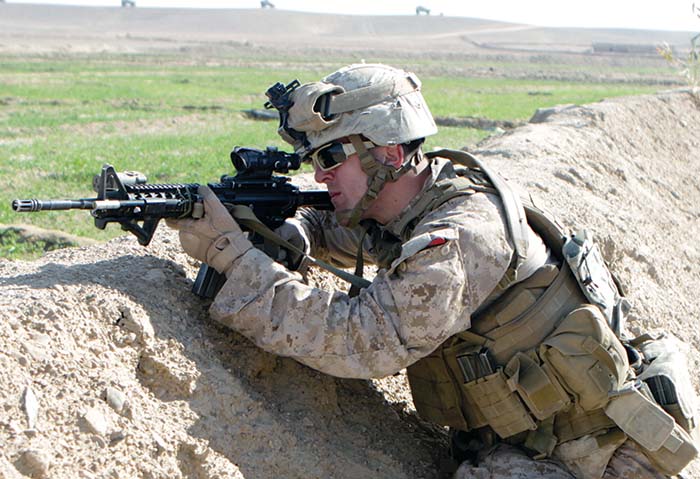A Marine rifle team leader scopes out suspicious activity while on a dismounted foot patrol in Nadi Ali district, Helmand province. This Marine has the Viking Tactical Two Point sling and has opted for a Magpul angled grip, which he isn’t even utilizing to balance his rifle. He has also opted for placing his magazines on a patrol belt instead of his front to leave his chest free. This allows for a much better prone position.
By Miles Vining
(Editor’s note: Marines are not authorized to carry unauthorized equipment. Sounds obvious, but the way it’s worked in combat from history’s day one is that the guys will choose what they like, and will always try to solve problems. SAR is neither condoning this nor encouraging this, but the reality is that combat use by Marines gives some interesting feedback for the potential buyer of products. The author is a true “gun guy” and we found his observations quite enlightening).
Almost more so than the traditional hunting bolt action rifle area of interest, today the AR or “Black Rifle” accessory business is huge and booming in the United States. The majority of these parts are intended for the civilian and law enforcement markets, which is ironic considering that this spawned out of the M16A2/A4/ M4 primarily in use by the U.S. Armed Forces. Some products are highly regarded and raved about in the States by civilians but reviews of how these products actually work in combat are very few in number. Peaceful conditions or competitions are quite contrasted when actually used under fire.
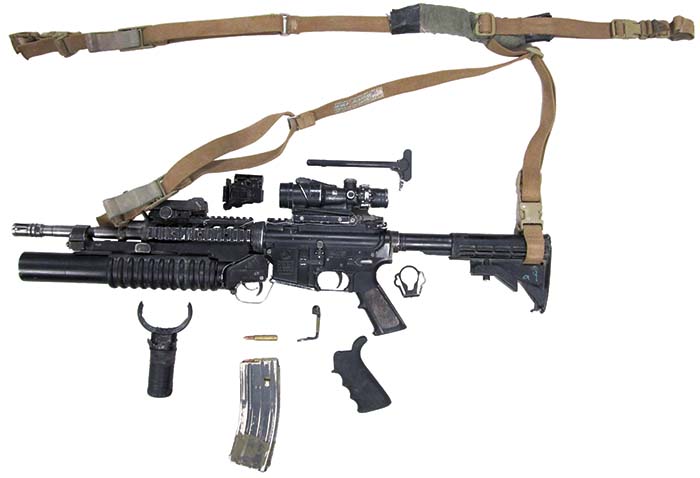
Between the months of September 2013 to May 2014, the author was a Marine Infantryman with 1st Battalion, 9th Marines, deployed to Helmand Province, Afghanistan. There the battalion used helicopter borne raids, dismounted and mounted patrols to take the fight to the Taliban. At this stage of the war most of the missions were centered around going into far off districts to hit Taliban command and control centers, and to protect the security of BLS (Bastion, Leatherneck, Shrobak, three combined bases that are ISAF’s front line in Helmand Province). These weren’t the days of Operation Mushtarak and pushing through the stronghold of Marjah, or the deadly districts of Sangin and Musaqula in which battalions of Marines fought the Taliban on a daily basis. But there was plenty of kinetic action with 1/9 in which the unit was engaged.
The following review of certain accessory items is strictly the opinion of this author. Some may agree or disagree. Regardless, it is worth repeating that these are the opinions of one soldier. This review is going to be on items that are T/O to an 0311 as well as items that the author personally supplemented to help in combat operations. Being well versed in the AR market, the author had some of the accessories that are often sought after in the civilian world and used them on deployment.
The author was issued an M4 carbine made by Colt. All Marine M4s are made by Colt and our M16A4s were on the FN Herstal contract. His billet was that of a team leader and the company made it a policy to get M4s to every Marine in a leadership position, as well as a new “Grenadier” position. As an SOP, a T/O Marine fire team has the team leader with an M4, a gunner with a SAW (although this is changing to the M27 IAR since its adoption in 2011), a grenadier with an M203A2 40mm
grenade launcher, and a point rifleman with an M16A4. But this changes from unit to unit to contend with operational tempo. For example in my former company it would be the team leader with an M203A2 but new TTPs switched it to a separate grenadier Marine.
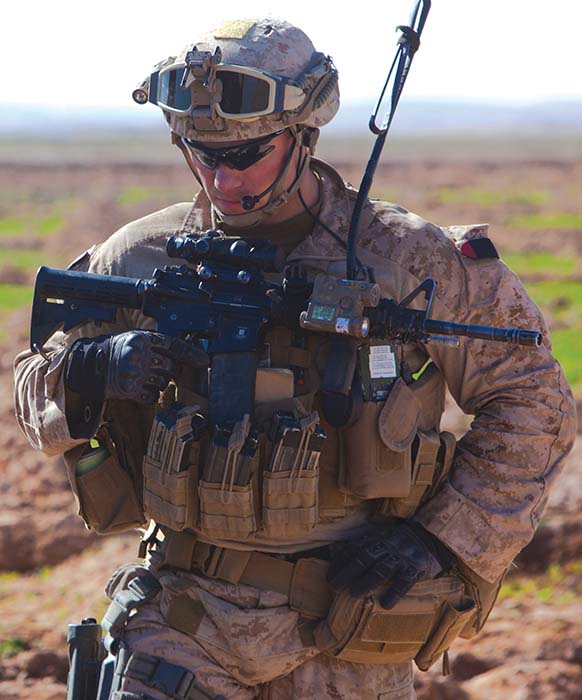
Trijicon RCO
The Trijicon 4x Rifle Combat Optic (RCO, aka the ACOG) is a phenomenal scope. The way we operate in theater, we cannot afford to be gentle with our weapons as much as we care for and constantly clean them. They are going to get dirty and they are going to get tossed around in MRAPs and MATVs over extremely intense terrain. They are going to be launched skyward when IEDs detonate. This harsh treatment is going to take place and it’s all part of the work hazard.
Nevertheless, our RCOs are extremely rugged and I have yet to see one break. They might shift their zero every once in a while if they take a severe beating but it isn’t by that much. To counter this we have held a BZO range every month in country and this has helped alleviate that wandering zero problem. As for the fighting, the 4x magnification is outstanding. The ROE has become increasingly restrictive every year the war has dragged on and making sure the enemy to be engaged has a weapon or not has been a strategic priority for ISAF forces. An EOTech would have been great in Iraq but most engagements in Helmand take place at 300 meters or further. As for the actual RCO, there’s some different uses of it.
Many RCOs are being issued with the plastic honey comb designated as the “Anti Reflection Device” or the ARD. The effectiveness of this piece is a moot point. Our dismounted patrols are usually 5 or more Marines per patrol. Already a huge target, spread out 15-20 meters apart, a little reflection from an RCO is not going to add to this target rich environment for the Taliban. Snipers have a much better use for this device as any target indicator from a hide site can mean the team is compromised. The plastic piece is held into the RCO by a taut elastic band wrapped around the base of the RCO. Eventually it gets knocked out of alignment and completely off and sometimes lost. Although it is a great idea of an addition to the weapon, its actual use through experience somewhat negates it entirely.
Insight AN PEQ 16B LED
Back in the early Iraq War days, Marines were issued the AN PEQ 1, basically just a IR and visible laser emitting module. This was upgraded in the early 2000s to the AN PEQ 15, which was smaller, had some more enhanced features when it came to adjusting lasers, and had the option of different types of IR lasers. Usually this was issued along with a massive Surefire flashlight. Then the AN PEQ 16 came around and it included a white light LED which made the separate weapon mounted Surefire light not required. Some units still use the PEQ 15, namely rear echelon units and Sniper Platoons. For a Scout Sniper Platoon, the PEQ 15 is favored because of its contoured design to the handguards, less weight and battery requirement, and because Snipers are generally not searching houses so don’t need the LED light as much as a line platoon that is constantly searching dark compounds or clearing buildings at night. The addition of the LED made rifles lighter as the flashlight was not present but one of the downsides is that the light itself takes up a lot of battery power. The PEQ 15 ran on a single 123 volt battery while the PEQ 16 runs on two, and even with this added power, the light will drain it rather quickly in a matter of a few hours. But if the user doesn’t use the light and just uses the IR or visible lasers, the unit will last a good while, a month or so of constant use on patrol.
Both models came with a slot that a remote ON/OFF button could be attached to. Marines generally attached this button to the magazine well via Velcro, directly in front of the trigger for quick activation. Holding down the PEQ 16 ‘s ON/OFF button will place it in momentary mode, while double tapping it will turn it to constant on and single tapping will turn it off.
The most vulnerable part about the PEQ 16 itself is the LED. Although there is a cover affixed by an elastic cord that protects the lens, this cord often breaks or rips off after prolonged periods of time and thus leaving the lens or bulb open to being smashed. Replacement of said part is easy to take care of at an armory, but if Marines are at a remote Patrol Base, this can take weeks of waiting to get to an armory in the rear at a FOB. Since the PEQ 16 has been in use for some time, various SL3 gear is in place to support it such as laser boresights and target sheets. These sheets are placed 10 meters away from the shooter in a prone position and have markers on them for various weapons
Blue Force Tactical Sling
The Blue Force Vickers Tactical Two Point sling was introduced to the Marine Corps via a back door in the form of the M27 Infantry Automatic Rifle (IAR). The Marine Corps liked it so much with the M27 that it was decided to adopt it en masse. Before this Two Point, the Marine Corps was using the Three Point combat sling, which in the authors opinion was perfectly fine and was better than the Vickers Tactical. The Vickers Tactical is very thin, holds the rifle too tight to the body and almost impossible to wear while actually on patrol with gear on. In fact some Marines forget the sling altogether and go unslung when on patrol. The benefits it does have are in the quick adjustment tab and the quick release clip on the stock. Something the author did while in Camp Leatherneck was he utilized the sling as a Two Point as per regulations. But when out on patrol, he took the sling off the weapon and married the clip on the rifle to a clip he had on his plate carrier, turning it into a One Point. This worked extremely well while on patrol.
Magpul BAD Lever
In the current market there are a number of bolt catch assistance devices that make operation of an AR much quicker than using the traditional palm slap to the side of the weapon. The specific aftermarket accessory that the author chose before the deployment was the infamous Magpul BAD lever, for no particular reason than its reputation and simplicity. The author locked it on the bolt catch at the start of the eight months and there was no need to retighten it as it didn’t come loose during the duration. While clearing the weapon it was especially useful as when all our gear is on, manipulation of just about anything at all becomes cumbersome and the ability to lock the bolt back or send it home with one hand was very helpful. During firefights was when it really shined. With one particular fight, one of the author’s magazines was faulty and caused a double feed – a very bad situation when rounds are cracking overhead. With the BAD lever the author simply locked the bolt back, dropped the magazine, swept the two rounds out and inserted a fresh source of ammunition, getting the rifle back in the fight.
Badger Ordnance Charging Handle
There is absolutely nothing wrong with the standard charging handle. The author chose a larger one though out of convenience, and personal preference. A technique mostly used in the infantry is to use the palm or fingers of the left hand to rack the charging handle to the rear. This proves a lot faster than indexing the T shaped handle with two fingers and breaking a cheek wield. When only using the palm, a shooter can also stay on target and movement of the weapon is minimized.
There are a number of companies that make oversize charging handles. The author went with Badger Ordnance because they have a good reputation and used some of their accessories before in the scope rings on the M40A5 sniper rifle. The only issue would be that the square design of the handle sometimes gets snagged on bits and pieces of gear but this is rare.
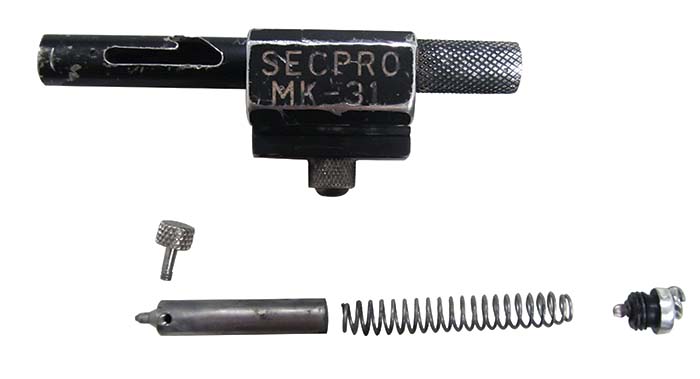
One Point Adapter by Viking Tactical
One of the author’s biggest pet peeves in the service was that of using One Point slings on M4s mostly but also M16s. When used correctly, the One Point sling is an awesome addition to a carbine sized weapon. But when used incorrectly, it can damage the weapon, and make a shooter complacent. The specific problem with One Point slings is the adapter to the weapon. Since the service M16/M4 was not produced to take a One Point, Marines have to use adapters that usually fit around the buffer tube of an M4 near the charging handle. These adapters are great for a standard M4 type carbine but Marines use more than the standard M4 – they attach PEQ16s, RCOs, pen flares, and M203 grenade launchers to it, which adds more weight than the adapter was designed for.
Over time, some adapters slide up the buffer tube from constantly being pulled down by all the weight. The other problem with these adapters is that many Marines don’t care to think of how they are attaching their slings to the weapon. Most One Point slings are attached via a metal clip. Bear in mind the adapter is made out of metal, and the rifle is constantly pivoting on that adapter because that is how the sling is connected to it. All that metal on metal friction does is grind away the adapter and in some extreme cases cuts through the entire swivel ring and makes it useless. The answer to this dilemma is to use cloth or some soft but tough material that won’t create friction. BOTach makes a plastic covered metal soft loop that attaches quite well. The author used plastic clips for the connection between sling and rifle. These served extremely well for the duration of the deployment.
Hogue AR Pistol Grip
The stock M16/M4 pistol grip is a simple and rugged part of the rifle that has worked flawlessly since Vietnam and continues to do so. As for personal preference, it is not a grip that the author favors in terms of weapon handling. It is much too narrow and rigid for the author’s tastes. Because of this he ordered a Hogue pistol grip with beavertail extension. Between Ergo, Magpul, and Hogue there were a host of choices in regards to a grip but the author went with Hogue because of their superior reputation in quality. The most attractive feature was the palm swells and finger grooves. As mentioned previously, the stock grip is rather narrow and the Hogue’s larger size and palm swells greatly improved handling. Stock grips have only one finger groove whereas the Hogue has three, thus much improving purchase on it while on the move or firing.
Although the Hogue is certainly a worthy grip, most Marines that do modify their pistol grips opt out with a Magpul grip due to its mainstream popularity. For personal preference, the Magpul grip is a fine grip in its own right but it just comes down to what is most useful to the individual shooter.
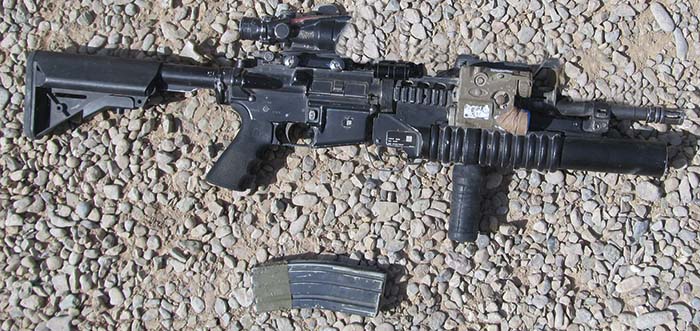
Grip Pod and Issue Broomhandle
The grip pod was designed with good intentions and is a good concept by combining a grip and a bipod so accuracy can be improved fleet wide instead of limiting bipod mounted weapons to just designated marksmen or machine
gunners. Unfortunately, in reality that does not play out and the author has a very negative opinion of the grip pod. It’s too large/bulky as a grip and too fragile as a bipod. It’s absolutely great if all a shooter is doing is gently setting the weapon on level ground while he’s attending to some trivial matter. But using it as a legitimate shooting support, in the rough and unforgiving space of a live fire range or in a gunfight, it is worthless and the legs will eventually break – and it is not adjustable for height. The author has no idea what the rage is with these things in the AR market in the States. But they seem to have caught on because they’re in such wide use by the military.
While on the topic of bipods, not many infantrymen use bipods with their M16A4 service rifles. But on designated marksmen rifles such as the 5.56x45mm Mk12 or M27 IAR, Harris bipods are issued with the rifles and these are especially useful. The only problem with them is that Harris bipods are designed for a specific role and that is to be used with long range rifles that are often carefully taken care of. When they are with a weapon such as the M27 that sees rough use, they start breaking down, screws come loose,
and springs wear.
The standard issue grip (otherwise known as a “broomhandle”) is prefect for operational use; it locks in tight from the bottom instead of from the side and provides a good basic grip. Some of the other commercially used grips in use by Marines are the Magpul MOE, the Viking Tactical grip, or discontinued M249 SAW forward grips are somewhat popular. Some Marines try the Magpul angled grip although it doesn’t suit the type of missions that infantry Marines in Helmand are tasked with. This grip is aimed at competition shooters or urban combat uses where when the rifle is pulled out it is used specifically for this intended purpose and put back. Infantry Marines take their rifle everywhere they go, and spend most of the time outside the wire patrolling from checkpoint to checkpoint with maybe kinetics occurring some of the time while on patrol.
LMT SOPMOD Butt Stock
The LMT stock was originally produced for use by Navy SEALs in the Naval Special Warfare Center in Crane, Indiana. LMT started producing it commercially and it has taken off from there. For simplicity and ruggedness, this stock beats out every other commercial M4 stock on the market, even the excellent Magpul ones. The best part about it is the extended cheek piece and narrow butt plate so it can fit snugly between a shoulder and body armor. Most M4 stocks, to include the issued ones, lack an extended cheek piece and this makes it hard to acquire a solid cheek weld. This isn’t an issue with the SOPMOD stock. All the British Special Operations troops used these stocks on their LMT or Diemaco M4 carbines. This is where some of the Marines got them from as they would have extra and would trade or give them to Marines occasionally.
RM Equipment M203 Grip
This grip doesn’t increase the effectiveness of the M203 40mm grenade launcher but is more for ease of handling. Carrying an M4/M203A2 is simple enough but it is nice to have a solid grip when on patrol or walking around a base overseas. The RM Equipment one is very well made and extremely durable. The profile of an M203 is already low enough that adding a Picatinny rail to it and then a broomhandle grip is almost absurd in how much lower that sticks out. RM Equipment’s grip latches right on to the launcher’s ribs and is short but not short enough that a shooter’s hand isn’t gripping air.
Survival Pen Flare Launcher
The pen flare launcher isn’t necessarily a true weapon accessory but due to operational requirements, it was adopted by Marines in 1/9. The reason for this was because of the strategic problems faced by ISAF forces at this late stage of the war. Zero tolerance for civilian casualties became an absolute necessity because of the Bi-Lateral Security Agreement between the government of Afghanistan and the United States.
As a stand-alone launcher, the MK31 is an excellent tool; it fires pen flare cartridges out to around 100-200 meters. Its primary intent was as a survival signaling device but 1/9 began using it as an Escalation of Force tool. But when mounted on a combat rifle they become banged up rather quickly as they are everywhere the rifle goes. In its survival role it is stored away in an escape and evade kit and only taken out
when necessary.
Magazines
Before 2013, the Marine Corps had no issue with Marines using polymer magazines in their rifles. An entire battalion from Hawaii even purchased a full supply to outfit the entire unit. But as of 2013, Marines are no longer allowed to use them as per regulations. The reasoning behind this is because the most popular polymer magazine, the 30 round Magpul Pmag, cannot be interchanged with the M27 IAR because of how that rifle’s magazine well is shaped. At the same time these regulations came out, Magpul also came out with their Gen 3 Pmag that could be used in the M27 IAR – very ironic indeed how that timing worked out. So for the most part, Marines with 1/9 used issued aluminum magazines throughout the deployment.
As mentioned previously the AR market in the United States is huge, it is quickly becoming the most popular rifle for hunting, target shooting, and law enforcement application all over. The author hopes that this essay will shed some light on how some of these aftermarket parts fare downrange for those readers that are heavily invested in ARs back home.
| This article first appeared in Small Arms Review V19N5 (June 2015) |



